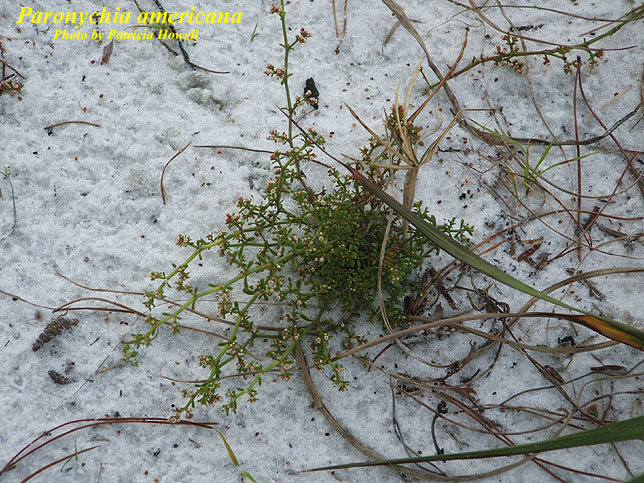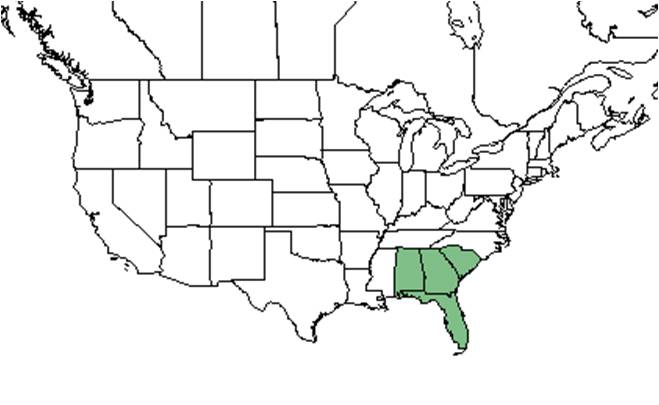Difference between revisions of "Paronychia americana"
(→Distribution) |
HaleighJoM (talk | contribs) (→Ecology) |
||
| (One intermediate revision by one other user not shown) | |||
| Line 45: | Line 45: | ||
<!--===Fire ecology===--> <!--Fire tolerance, fire dependence, adaptive fire responses--> | <!--===Fire ecology===--> <!--Fire tolerance, fire dependence, adaptive fire responses--> | ||
===Pollination=== | ===Pollination=== | ||
| − | + | ''Paronychia americana'' has been observed at the Archbold Biological Station to host sweat bees from the Halictidae family such as ''Lasioglossum nymphalis'' and ''L. placidensis'' and wasps from the Vespidae family such as ''Leptochilus krombeini''.<ref name="Deyrup 2015">Deyrup, M.A. and N.D. 2015. Database of observations of Hymenoptera visitations to flowers of plants on Archbold Biological Station, Florida, USA.</ref> | |
| − | + | <!--===Herbivory and toxicology===--> | |
| − | |||
| − | |||
| − | |||
| − | <!--=== | ||
<!--===Diseases and parasites===--> | <!--===Diseases and parasites===--> | ||
Latest revision as of 20:22, 14 July 2022
| Paronychia americana | |
|---|---|

| |
| Photo by Patricia Howell, Atlas of Florida Vascular Plants | |
| Scientific classification | |
| Kingdom: | Plantae |
| Division: | Magnoliophyta - Flowering plants |
| Class: | Magnoliopsida – Dicotyledons |
| Order: | Caryophyllales |
| Family: | Caryophyllaceae |
| Genus: | Paronychia |
| Species: | P. americana |
| Binomial name | |
| Paronychia americana (Nutt.) Fenzl ex Walp. | |

| |
| Natural range of Paronychia americana from USDA NRCS Plants Database. | |
Common names: American nailwort; American whitlow-wort
Contents
Taxonomic notes
Synonyms: Siphonychia americana (Nuttall) Torrey & Gray; Siphonychia pauciflora Small.[1]
Varieties: none.[1]
Description
A description of Paronychia americana is provided in The Flora of North America.
P. americana is a sprawling, ascending, or erect annual. Leaves are elliptic or spatulate, 4-18 mm long, and 1-2.5 mm wide, with usually conspicuous stipules. The calyx is purple with a pubescent and globose tube. The tube is 0.5 mm long with 0.5 mm long calyx lobes. The sepals are white-scarious-margined, broadly rounded, and hooded. There is a densely pubescent on the basal portion of the sepals and this portion is nearly ½ its length. The stem is glabrous or has one side with curly hairs.[1][2]
Distribution
Paronychia americana is endemic to an area from southern South Carolina to peninsular Florida, but the majority is found in Florida.[3]
Ecology
Habitat
Paronychia americana can occur in sandhills, sand pine scrubs, turkey oak woods, wiregrass savannas, and grassy recreation fields. [4] Associated species include sand pine, live oak, turkey oak, bluejack oak, and wiregrass. [4]
Phenology
This species flowers from June through September.[1]
Pollination
Paronychia americana has been observed at the Archbold Biological Station to host sweat bees from the Halictidae family such as Lasioglossum nymphalis and L. placidensis and wasps from the Vespidae family such as Leptochilus krombeini.[5]
Conservation, cultivation, and restoration
Cultural use
Photo Gallery
References and notes
- ↑ 1.0 1.1 1.2 1.3 Weakley, A.S. 2015. Flora of the southern and mid-atlantic states. Working Draft of 21 May 2015. University of North Carolina at Chapel Hill, Chapel Hill, North Carolina.
- ↑ Radford, A. E., Ahles, H. E., & Bell, C. R. (1968). Manual of the vascular flora of the Carolinas. Chapel Hill: University of North Carolina Press.
- ↑ Sorrie, B. A. and A. S. Weakley 2001. Coastal Plain valcular plant endemics: Phytogeographic patterns. Castanea 66: 50-82.
- ↑ 4.0 4.1 Florida State University Robert K. Godfrey Herbarium database. URL: http://herbarium.bio.fsu.edu. Last accessed: October 2015. Collectors: Loran C. Anderson, Michael B. Brooks, George R. Cooley, Bob Fewster, Robert K. Godfrey, Mike Jenkins, Walter Judd, R. Kral, Sidney McDaniel, Marc Minno, Joseph Monachino, Cecil R. Slaughter, Bian Tan, R.L. Wilbur. States and Counties: Alabama: Pike. Florida: Brevard, Collier, Columbia, Hernando, Flagler, Lake, Leon, Palm Beach. Georgia: Emanuel, Laurens, Telfair. Compiled by Tall Timbers Research Station and Land Conservancy.
- ↑ Deyrup, M.A. and N.D. 2015. Database of observations of Hymenoptera visitations to flowers of plants on Archbold Biological Station, Florida, USA.